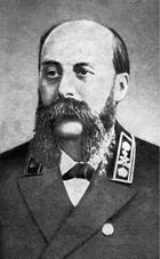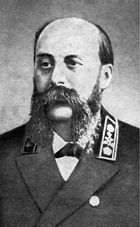
Nikolay Apollonovich Belelyubski
Encyclopedia

Biography
Nikolai Belelyubski was born in KharkivKharkiv
Kharkiv or Kharkov is the second-largest city in Ukraine.The city was founded in 1654 and was a major centre of Ukrainian culture in the Russian Empire. Kharkiv became the first city in Ukraine where the Ukrainian Soviet Socialist Republic was proclaimed in December 1917 and Soviet government was...
on March 13, 1845. He spent his childhood and youth in Taganrog
Taganrog
Taganrog is a seaport city in Rostov Oblast, Russia, located on the north shore of Taganrog Bay , several kilometers west of the mouth of the Don River. Population: -History of Taganrog:...
, and graduated with a golden medal from the Taganrog Boys Gymnasium
Chekhov Gymnasium
The Chekhov Gymnasium in Taganrog on Ulitsa Oktyabrskaya 9 is the oldest gymnasium in the South of Russia. Playwright and short-story writer Anton Chekhov spent 11 years in the school, which was later named after him and transformed into a literary museum...
in 1862. Belelyubski entered the Institute of Railroad Engineers in Saint Petersburg
Saint Petersburg
Saint Petersburg is a city and a federal subject of Russia located on the Neva River at the head of the Gulf of Finland on the Baltic Sea...
, which he graduated in 1867. He was considered one of the Institute's best graduates of all time, his name was written on a marble plate, and he offered the position of a teacher for construction mechanics, bridges and hydraulics. Professor (since 1873) Belelyubski also lectured at the Mountain Institute (Горный институт), Institute of Civil Engineers and Imperial Academy of Arts
Imperial Academy of Arts
The Russian Academy of Arts, informally known as the St. Petersburg Academy of Arts, was founded in 1757 by Ivan Shuvalov under the name Academy of the Three Noblest Arts. Catherine the Great renamed it the Imperial Academy of Arts and commissioned a new building, completed 25 years later in 1789...
. His scientific and practical work in bridge-building and research of construction materials gained him a worldwide recognition.
Professor Belelyubski personally designed and managed over 100 projects of long bridges. The total length of bridges built by his projects extends 17 kilometers. This includes the bridges over rivers Don
Don River (Russia)
The Don River is one of the major rivers of Russia. It rises in the town of Novomoskovsk 60 kilometres southeast from Tula, southeast of Moscow, and flows for a distance of about 1,950 kilometres to the Sea of Azov....
, Danube
Danube
The Danube is a river in the Central Europe and the Europe's second longest river after the Volga. It is classified as an international waterway....
, Ob
Ob River
The Ob River , also Obi, is a major river in western Siberia, Russia and is the world's seventh longest river. It is the westernmost of the three great Siberian rivers that flow into the Arctic Ocean .The Gulf of Ob is the world's longest estuary.-Names:The Ob is known to the Khanty people as the...
, Kama
Kama
Kāma is often translated from Sanskrit as sexual desire, sexual pleasure, sensual gratification, sexual fulfillment, or eros54654564+more broadly mean desire, wish, passion, longing, pleasure of the senses, the aesthetic enjoyment of life, affection, or love, without sexual connotations.-Kama in...
, Oka
Oka River
Oka is a river in central Russia, the largest right tributary of the Volga. It flows through the regions of Oryol, Tula, Kaluga, Moscow, Ryazan, Vladimir, and Nizhny Novgorod and is navigable over a large part of its total length, as far upstream as to the town of Kaluga. Its length exceeds...
, Neva, Irtish, Belaya, Ufa
Ufa
-Demographics:Nationally, dominated by Russian , Bashkirs and Tatars . In addition, numerous are Ukrainians , Chuvash , Mari , Belarusians , Mordovians , Armenian , Germans , Jews , Azeris .-Government and administration:Local...
, Nieman, Berezina and many more. The railway bridge over the Volga
Syzran Bridge
The Alexander Railway Bridge across the Volga River near Syzran, so named after the reigning emperor Alexander II, was designed by Nikolai Belelyubsky and Konstantin Mikhailovsky. The first bridge across the Volga in its lower reaches, it was opened by Konstantin Posyet in 1880 as part of the...
near Syzran
Syzran
Syzran is the third largest city in Samara Oblast, Russia, located on the right bank of Saratov Reservoir of the Volga River. Population: It was founded in 1683 as a fortress, and was granted town status in 1796. One tower from the 17th-century fortress still stands...
built in 1875-1880 was the longest bridge in Europe
Europe
Europe is, by convention, one of the world's seven continents. Comprising the westernmost peninsula of Eurasia, Europe is generally 'divided' from Asia to its east by the watershed divides of the Ural and Caucasus Mountains, the Ural River, the Caspian and Black Seas, and the waterways connecting...
for a long period of time. This bridge or girder
Girder
A girder is a support beam used in construction. Girders often have an I-beam cross section for strength, but may also have a box shape, Z shape or other forms. Girder is the term used to denote the main horizontal support of a structure which supports smaller beams...
system has 13 spans (each of 107 meters) with a total length of 1483 meters. The bridge connected the railroad network in the central Russia with Volga region and Siberia
Siberia
Siberia is an extensive region constituting almost all of Northern Asia. Comprising the central and eastern portion of the Russian Federation, it was part of the Soviet Union from its beginning, as its predecessor states, the Tsardom of Russia and the Russian Empire, conquered it during the 16th...
. Belelyubski's project of a bridge over Volga on Oktyabrskaya railroad (1888) was the first time when the hinged support of cross-beams was used, and later awarded with a medal at the Edinburg
Edinburg
Edinburg may refer to a place in South Africa:* Edinburg, North West* Edinburg, MpumalangaEdinburg may refer to a place in the United States:* Edinburg, Illinois* Edinburg, Iowa* Edinburg, Maine* Edinburg, Mississippi* Edinburg, Missouri...
Expo in 1896.
Nikolay Apollonovich promoted Russian science and its achievements, representing the country at various international exhibitions and forums. In several world expos (Edinburg, 1890; Chicago 1893
World's Columbian Exposition
The World's Columbian Exposition was a World's Fair held in Chicago in 1893 to celebrate the 400th anniversary of Christopher Columbus's arrival in the New World in 1492. Chicago bested New York City; Washington, D.C.; and St...
; and five expos held in Paris) the work of Belelyubski was presented through books, drawings and bridge models. He was member of the International Association of Railroad Congresses, honorary member of the Society of Civil Engineers of France and honorary member of the Institute of Concrete in England
England
England is a country that is part of the United Kingdom. It shares land borders with Scotland to the north and Wales to the west; the Irish Sea is to the north west, the Celtic Sea to the south west, with the North Sea to the east and the English Channel to the south separating it from continental...
. In the World Expo 1900
Exposition Universelle (1900)
The Exposition Universelle of 1900 was a world's fair held in Paris, France, from April 15 to November 12, 1900, to celebrate the achievements of the past century and to accelerate development into the next...
in Paris
Paris
Paris is the capital and largest city in France, situated on the river Seine, in northern France, at the heart of the Île-de-France region...
, Belelyubski received the highest award.
Nikolay Belelyubski died on August 4, 1922 in Saint Petersburg
Saint Petersburg
Saint Petersburg is a city and a federal subject of Russia located on the Neva River at the head of the Gulf of Finland on the Baltic Sea...
, and was buried at Novodevichy Cemetery
Novodevichy Cemetery
Novodevichy Cemetery is the most famous cemetery in Moscow, Russia. It is next to the 16th-century Novodevichy Convent, which is the city's third most popular tourist site. It should not be confused with the Novodevichy Cemetery in Saint Petersburg....
.
External links and references
- «Энциклопедия Таганрога». — Ростов-на-Дону: Ростиздат, 2003. — 512 с. — ISBN 5-7509-0662-0

